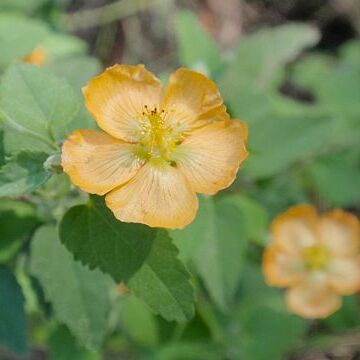Subshrubs, 1–1.5 m. Stems erect, stellate-tomentulose, without simple hairs. Leaves: stipules subulate, 2 mm; petiole shorter than blade; blade ± concolorous, ovate, 2–10 cm (often smaller), somewhat longer than wide, base cordate, margins irregularly serrate, apex acute, surfaces minutely stellate-pubescent. Inflorescences solitary flowers or terminal panicles. Flowers: calyx 3–5 mm, lobes not overlapping, reflexed in fruit, lanceolate-ovate, to 8 mm wide; corolla yellow throughout, petals 5–10 mm; staminal column glabrous; style 6–9-branched. Schizocarps cask-shaped, 8–9 × 8–9 mm; mericarps: apex acute or apiculate, surface tomentulose. Seeds 3 per mericarp, 2 mm, puberulent but appearing glabrous. 2n = 14.
Mericarps usually c. 10, broadly keeled in apical half (hence fruit in upper half characteristically furrowed between the mericarps), obliquely truncate-convex at the apex with the dorsal angle subacute to shortly mucronate but not awned, when not yet ripe densely and shortly greyish-green, ultimately grey-brown, stellate-tomentose dorsally and on the apical dorsal area of the flat sides, not turning black.
Leaf-lamina 2–6 (10) × 1·5–4 (6) cm., apex obtuse to acute or somewhat acuminate, margin usually subentire to slightly crenate or serrate, less often more conspicuously serrate, upper surface grey-green with indistinct venation, lower surface paler and canescent with distinct somewhat prominent venation; petiole somewhat shorter or slightly longer than the corresponding lamina.
A herb or small shrub. It keeps growing from year to year. It has many branches. It is hairy. It grows 1 m tall. The leaves are 1-8 cm long by 2 cm wide. They are heart shaped at the base. They can have teeth. The flowers occurs singly in the axils of the leaves. The flowers are yellow. The fruit are 8 mm long by 10 mm wide.
Shrub 0·5–1·25 (2) m. tall, much branched, canescent to glaucous-grey with a dense very short velvety indumentum; stems terete, slender, at length glabrescent, woody and ultimately covered with a light brown or greyish bark with short darker linear markings.
Shrub, 0.50-1.25(-2.00) m high. Flowers opening in the morning. Mericarps 10, broadly keeled in apical half, giving fruit characteristic ribbed appearance. Flowers yellow, orange to apricot.
Calyx 5–6 mm. long, broadly campanulate to cupular, divided to about the middle; lobes triangular or triangular-ovate, mucronate, minutely ciliate, with indistinct median vein.
Flowers solitary on the main branches and/or on short leafy axillary shoots; pedicels 0·5–4 (8) cm. long, slender, terete, articulated near the apex.
Fruit 8 × 10–12 mm., broadly cylindric with rounded base, widely and shallowly umbilicate.
Seeds usually 3, c. 1·5 × 1·5 mm., usually greyish-brown, minutely verruculose-punctate.
A hoary, much-branched, woody perennial, 3–6 ft. high
Staminal tube stellate-hairy.
Comparatively small leaves
Petals 7–10 mm. long.
Carpels 2–3-seeded.
Flowers yellow

